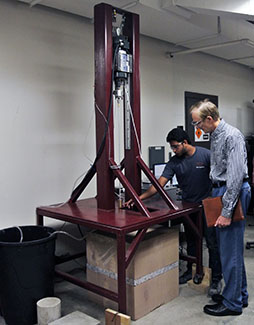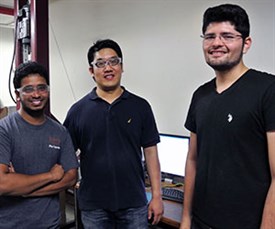 A team of four engineering students from Texas A&M University placed second in the inaugural Drillbotics Competition hosted by the Society of Petroleum Engineers Drilling Systems Automation Technical Section (SPE DSATS).
A team of four engineering students from Texas A&M University placed second in the inaugural Drillbotics Competition hosted by the Society of Petroleum Engineers Drilling Systems Automation Technical Section (SPE DSATS).
The competition was created to give students the opportunity to test their engineering and teamwork skills by establishing their own multidisciplinary teams of four to five students to build a miniature robotic drilling rig inside a lab. When finished, they used these automated drilling rigs to drill a sample formation provided by DSATS. The goal was to drill the multi-rock layered sample with the fastest, straightest hole in the most energy- and cost-efficient manner.
Panels of judges working in the petroleum industry visited each university to watch as the students tested the automated drill rigs they created to see which system would best handle an unknown formation sample.
The four teams participating were from The University of Texas at Austin, Texas A&M University, The University of Oklahoma, and Norway’s University of Agder.
The Texas A&M team included graduate students John Kim (petroleum engineering), Prudhvi Maddineni (electrical and computer engineering), Seounghyun Rho (petroleum engineering), and Narendra Vishnumolakala (petroleum engineering). Vishnumolakala and Rho are shown left and middle in photo below with Enrique Zarate (petroleum engineering), an advisor. The team was also advised and assisted by Dr. Satish Bukkapatnam’s research group (industrial and system engineering), and Dr. Eduardo Gildin and Dr. Sam Noynaert (petroleum engineering).
“I am very proud of these students. They did a great job, especially for a competition in its first year which had quite a few questions and uncertainties throughout the entire process,” said Noynaert. “They did it all on their own, with only a limited amount of help from the faculty.”
 The team from the University of Oklahoma was the winner and will exhibit its rig at the 2015 SPE Annual Technical Conference and Exhibition (ATCE) in Houston this September. The team will also present a paper at the conference.
The team from the University of Oklahoma was the winner and will exhibit its rig at the 2015 SPE Annual Technical Conference and Exhibition (ATCE) in Houston this September. The team will also present a paper at the conference.
The teams from Texas A&M and Texas, which came in third, will also present their work at the DSATS symposium at the ATCE.
Prior to drilling, all student teams had to complete two stages of preparation. First, a design stage where they submitted a full engineering design for the competition committee to review. Once approved, they proceeded to the building and testing stage. The rigs were approximately eight feet tall, which necessitated having the judges visit each university rather than moving the rigs to one location. Baker Hughes and National Oilwell Varco provided the drillbits and drillstrings. The students designed and built (or had built) all of the other rig components, including the automated control systems.
From start to finish the competition took 13 months. The teams were tested with purposeful alterations in the provided materials, which forced quick redesigns and produced unusual outcomes that reflected the difficulties brought on by real world situations industry often face in the field.
The Texas A&M team conducted its portion of the competition on June 12, beginning with a brief presentation in front of a panel of industry judges from Baker Hughes, National Oilwell Varco, and Shell. The rig test was then conducted.
The only time human intervention was allowed was during the placement of the drill bit on the surface of the formation. From that point, the rig was required to drill ahead and handle any dysfunctions (drillstring dynamics issues, changes in rock types, etc.) on its own.